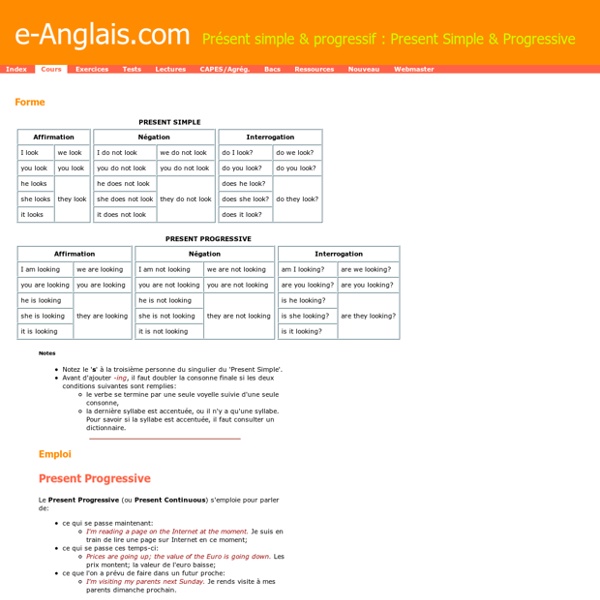Present Simple & Present Progressive: présent simple et présent progressif ou continu

Simple Present And Present Continuous Tense Exercise
Fill in the blanks with a present simple or present continuous tense form. 1. I ............................ my homework. The present continuous is used to talk about actions or situations that are going on at the moment of speaking. 2. We use the simple present to talk about our jobs. 3. We use the present continuous to talk about temporary situations. 4. We use the simple present to talk about habits and routines. 5. 6. 7. The present simple is used to talk about facts and habits. 8. We use the present simple to ask about habits and preferences. 9. The present simple is used to talk about timetabled events. 10. 11. 12. The present simple is used to talk about habits. Please share this quiz to view your results . Answers 1.
Present Simple and Present Continuous
New Update: EC offers various English courses, including online English speaking courses 'I surf / I am surfing.' What's the difference between the Present Simple / Present Continuous and how to use them. We use the present simple tense when we want to talk about fixed habits or routines – things that don’t change. We use the present continuous to talk about actions which are happening at the present moment, but will soon finish. Compare these two statements: (present simple) I play tennis. (present simple) ‘I play tennis’ tells us that playing tennis is something the speaker always does. (present continuous/ progressive) ‘I am playing tennis’ tells us that the speaker is playing tennis right now. With the present simple we say: I play tennis You play tennis We play tennis They play tennis He/she/ it plays tennis. With the present continuous we say: I am playing tennis You are playing tennis We are playing tennis He/she/it is playing tennis Frequency Adverbs we use with the Present Simple
Simple Present or Present Progressive/Continuous
In order to keep this offer free of charge, we and our partners (193) need your consent. This allows us to use cookies and similar technologies to show you ads tailored to your interests based on your user behaviour. Your data will only be processed for the purposes described in detail here. Here, you can also revoke consent at any time with effect for the future. Please note: The consent provided here is specific to the services of this website.
Present Simple or Present Continuous? - Exercise 1
Choose the correct form for each verb. Click on the button beside the correct answer. Don't give Jan any cheese. She ________ it! hates is hatingYou won't find Jerry at home right now.
Simple Present vs. Present Progressive
Exercises and tests Form See also explanations on Simple Present and Present Progressive Use In general or right now? Do you want to express that something happens in general or that something is happening right now? Timetable / Schedule or arrangement? Do you want to express that something is arranged for the near future? Daily routine or just for a limited period of time? Do you want to talk about a daily routine? Certain Verbs The following verbs are usually only used in Simple Present (not in the progressive form). state: be, cost, fit, mean, suitExample: We are on holiday. possession: belong, haveExample: Sam has a cat. senses: feel, hear, see, smell, taste, touchExample: He feels the cold. feelings: hate, hope, like, love, prefer, regret, want, wishExample: Jane loves pizza. brain work: believe, know, think, understandExample: I believe you. Exercies on Simple Present and Present Progressive Tests on Simple Present and Present Progressive
Present Simple or Present Continuous 1
What's my English grammar level? Take the free quiz here!x MethodExercisesExplanationsSpeakingMembershipCoursesContactLogin Present Continuous or Present Simple Exercise 1 Perfect English Grammar Choose the present simple or the present continuous. Choose Present Continuous or Present Simple 1 Choose the present simple or the present continuous - it could be positive, negative or question Hello! Click here to read more about our learning method Master English grammar for only $25 per month.
Related:
Related:



